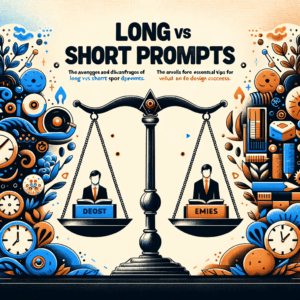
Common Mistakes In AI Prompts: Avoid Costly Errors Today!
- Understanding AI Prompts
- Lack of Clarity
- Overly Complex Instructions
- Forgetting Context
- Ignoring the Target Audience
- Failing to Ask for Specific Formats
- Neglecting Feedback
- Not Experimenting Enough
- Relying on AI Too Heavily
- Not Updating Prompts
- Ignoring Ethical Considerations
- Keeping Track of Good Prompts
- Conclusion
- Frequently Asked Questions
- References
Understanding AI Prompts
Artificial Intelligence (AI) has transformed how we interact with technology. From chatbots to content creation, effective AI prompts can unlock incredible potential. However, many people make common mistakes when crafting these prompts. Understanding these pitfalls helps you avoid costly errors. Let’s explore the most frequent missteps and how to improve your prompts.
Prompts are the questions or commands we give to AI. They act as a bridge between human intention and machine understanding. Therefore, clarifying what you want is critical. A well-defined prompt can lead to meaningful responses, while vague instructions can cause confusion and frustration.
Lack of Clarity
One major mistake is not being clear about your expectations. Ambiguous prompts can lead to irrelevant responses. For example, if you ask an AI, “Tell me about dogs,” it may provide information about different dog breeds. However, if you’re looking for dog training tips, your result may not hit the mark.
To avoid this issue, be specific. Define what you want for AI to deliver meaningful responses. Instead of saying, “Tell me about cars,” try, “What are the top five electric cars for 2023?” This specificity helps the AI understand your intentions better.
Overly Complex Instructions
Another common error is using overly complex language or convoluted sentences. While it might feel sophisticated, it can confuse the AI. For instance, asking, “Can you elucidate the variances among various models of electric vehicles regarding efficiency?” could overwhelm the algorithm.
Instead, simplify your language. Use straightforward words and short sentences. Request, “What are the differences in efficiency among electric car models?” This approach makes it easier for AI to process your request and deliver a focused response.
Forgetting Context
AI functions best with context. If you don’t provide sufficient background information, the AI struggles to generate a relevant answer. For example, if you say, “Explain how to fix it,” the AI has no idea what “it” refers to.
Add context to your prompts. Use background information to set the scene. Instead of saying, “How do I prepare for an interview?” try, “What should I prepare for a job interview in the tech industry?” This extra detail helps the AI target the answer to your needs.
Ignoring the Target Audience
Another frequent mistake is not considering the target audience. A prompt tailored to one group may not resonate with another. For instance, asking for “tips on exercise” may yield very different results depending on whether the audience is beginners or experienced athletes.
Always think about who will consume the information. Customize your prompt accordingly. Instead of saying just “exercise tips,” specify, “What are the best beginner workout tips for individuals aged 40 and above?” This creates a more tailored response and ensures the information is relevant.
Failing to Ask for Specific Formats
Many people overlook the importance of specifying the desired format for a response. If you don’t indicate how you want the information presented, the AI may not align with your expectations. For instance, asking, “What are the benefits of meditation?” might generate a paragraph. However, if you need bullet points for a presentation, the answer misses the mark.
To avoid this, specify the format you want. You could prompt, “List the top five benefits of meditation in bullet points.” This instruction ensures that the AI provides the information in a way that fits your needs.
Neglecting Feedback
A crucial aspect of working with AI is providing feedback. Ignoring this step can hinder the quality of responses. Many users ask for something, receive an answer, and don’t refine their prompt based on that result.
Encouraging a feedback loop can improve outcomes. If the initial response isn’t satisfactory, refine your prompt and try again. For example, if the AI provides a list that lacks depth, you might follow up with, “Can you provide more detailed explanations for each benefit mentioned?”
Not Experimenting Enough
Experimentation is key when crafting AI prompts. Sticking to a single method or approach may limit your outcomes. Many users become discouraged after one failed attempt, assuming AI isn’t effective.
Change your prompts and try various wording. For example, if “What are common cooking techniques?” didn’t yield satisfactory results, try asking, “Can you provide five essential cooking methods for beginners?” This approach often leads to richer responses and insights.
Relying on AI Too Heavily
AI is a powerful tool, but users often rely too much on it. While the technology is impressive, it can’t replace human intuition or critical thinking. Over-relying on AI can yield half-baked ideas or inaccurate information.
Ensure you balance machine-generated insights with your judgment. Once you receive an AI response, evaluate it with a critical eye. Use the information as a foundation to build on, rather than taking it at face value.
Not Updating Prompts
The rapidly changing nature of technology and information means prompts may quickly become outdated. Users often continue to use old prompts without consideration for current context or relevance. This stagnation stunts your progress and can lead to irrelevant outcomes.
Keep your prompts fresh and updated. Regularly assess their effectiveness. If something new arises, adjust your prompts accordingly. This practice keeps your questions aligned with the latest trends or information in your field.
Ignoring Ethical Considerations
AI can generate vast amounts of information, yet ethical considerations are essential. Ignoring ethical guidelines can lead to harmful outcomes. For example, prompting for content that promotes hate speech or misinformation can have severe consequences.
Always approach AI usage with a sense of responsibility. Ensure your prompts do not encourage harmful or unethical practices. Request information in a way that respects human dignity and truth.
Keeping Track of Good Prompts
As you begin to develop more effective AI prompts, it’s crucial to track your successful attempts. This practice allows you to revisit effective phrasing and apply them in future projects. However, many users fail to document their best prompts, which leads to repetitive mistakes.
Create a log of effective prompts and their outcomes. Review it regularly for inspiration. This strategy not only minimizes errors but also fosters continuous learning in the prompt crafting process.
Conclusion
Understanding the common mistakes in crafting AI prompts can save time and improve results. Clarity, specificity, and context are fundamental elements in creating effective prompts. Additionally, being aware of your audience and feedback can significantly enhance the quality of your AI interactions.
Be open to experimentation and remain ethical in your approaches. These practices will help you avoid costly errors and make the most out of AI technologies.
Frequently Asked Questions
1. What are the main factors to consider when crafting AI prompts?
Focus on clarity, context, target audience, and specific formats.
2. How can I improve my AI responses?
Experiment with different wording, provide feedback, and update your prompts regularly.
3. How do I know if my prompt was effective?
Review the quality of the response. Does it align with your expectations? If not, refine the prompt.
4. Is there a specific structure I should follow for prompts?
While not mandatory, clear and concise language helps AI understand better. Specify any desired formats.
5. Are there any ethical guidelines for using AI prompts?
Always ensure your prompts do not promote harmful or unethical behavior.
6. What if the AI doesn’t understand my prompt?
Rephrase your prompt. Simplify any complex language and provide context.
7. Can I trust all AI-generated information?
Always critically evaluate AI responses. Use them as a starting point, not a final answer.
8. Should I document my interactions with AI?
Yes! Keeping a record helps you identify effective prompts for future use.
9. What if my prompt leads to irrelevant answers?
Analyze the prompt for clarity and specificity. Tweak the wording or add context.
10. How do I deal with limitations in AI technology?
Understand the constraints and combine AI outputs with your insights for a balanced approach.
References
1. OpenAI. (2023). Understanding AI Language Models. Retrieved from OpenAI
2. MIT Technology Review. (2023). The Future of Artificial Intelligence. Retrieved from MIT Technology Review
3. Stanford University. (2023). Ethical AI Frameworks. Retrieved from Stanford
4. Harvard Business Review. (2023). Best Practices for AI Implementation. Retrieved from HBR
By avoiding these common mistakes and refining your approach to AI prompts, you’re on a path to achieving productive and innovative AI interactions. Happy prompting!

